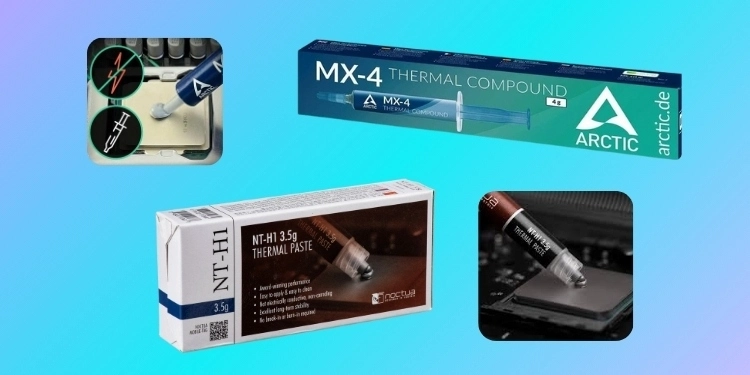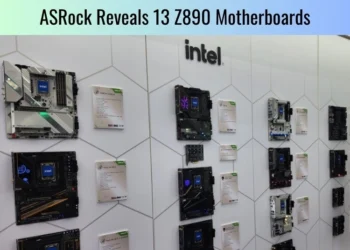It’s essential to keep your CPU cool for the best performance. But with so many thermal pastes available, choosing one can be challenging. Have you spent a long time looking at different pastes and still need clarification? You’re not alone. Picking thermal paste can be confusing.
But don’t worry – help is here! This guide will tell you all about the top CPU pastes. We’ll look at what makes some pastes better than others. Things like how well they move heat and how thick they are. We’ll also look at how long they last.
By the end, you’ll understand the differences between pastes and be able to pick the right one for your CPU.
What to Look For in a Quality Thermal Paste
Before recommending products, it’s crucial to understand what makes an excellent thermal paste for a CPU. The three main attributes to focus on include:
Thermal Conductivity
This describes a paste’s capacity to transfer heat from the CPU to the attached cooler efficiently. Materials with higher thermal conductivity, measured in W/mK, allow for better dissipation of waste heat. In general, aim for 8W/mK or more for optimal cooling capacity.
Viscosity
The thickness of a paste refers to how easily it spreads. A balance must be struck – too runny, and it may seep out; too thick, and gaps can form. Most reputable pastes have a smooth, toothpaste-like consistency for simple, even application.
Longevity
Look for solutions formulated to retain effectiveness for years. Some eventually harden while others stay fresh. Quality pastes also resist “pump-out,” where vibration causes the paste to be slowly squeezed away over time.
With critical factors understood, let’s examine the best thermal pastes for CPUs based on extensive reviews and tests.
The Best Thermal Pastes for CPUs: Detailed Reviews
With an understanding of what makes a quality thermal paste, it’s time to examine some top-rated options. Several products stood out from the literature research. Let’s take a closer look at these leading CPU thermal pastes, analyzing their crucial characteristics in more depth.
Arctic MX-4
The Arctic MX-4 impresses me with its blend of characteristics. It features 8.5W/mK conductivity, efficiently transferring heat. Maintaining a 4/5 rated pliable consistency, application proves easy.
Tests show that the MX-4 is performing consistently against new formulations. Its extended durability stems from its resistance to hardening or drying out over time. Also, because it is non-conductive, it’s safe for all system types. Overall, it’s an excellent all-purpose option.
Pros:
- Thermal conductivity of 8.5W/mK
- Smooth, easy to apply consistency
- Excellent longevity and resistance to pump-out
- Non-conductive for broad compatibility
- Tried and tested performance
- Affordable price
Cons:
- None really
Price: Around $7-8

Noctua NT-H1
Noctua is a favorite brand among enthusiasts for good reason. Their NT-H1 thermal paste strikes an ideal balance, with 8.9W/mK thermal conductivity and a rated 4.5/5 for user-friendliness.
Independent benchmarks show heat-spreading abilities on par with more expensive alternatives. Its notable long-term stability seals its reputation for reliable, hassle-free cooling. It is also non-electrically conductive, making it compatible with all cooling solutions.
Pros:
- Thermal conductivity of 8.9W/mK
- Easy to apply and spread evenly
- Excellent long-term stability
- Non-conductive and safe for all systems
- Competitive performance for the price
Cons:
- Slightly higher price than some options
Price: Around $8-10
Thermal Grizzly Kryonaut
As a premium offering, the Kryonaut lives up to the hype with 12.5W/mK thermal conductivity. Its low viscosity eases application between tight more astonishing mounting points and later removal.
These features often make it outperform cheaper pastes in extreme overclocking and heavy workloads. More demanding usages justify its somewhat higher cost.
Pros:
- Exceptional thermal conductivity of 12.5W/mK
- Impressive performance, especially for extreme OC
- Easy to apply and remove
- Suitable for all cooling solutions
Cons:
- Higher price point than most options
Price: Around $11-13

Gelid GC-Extreme
The Gelid GC-Extreme needs to be top conductivity. However, its thick “pump-out resistant” consistency proves a winner for graphics cards. With 8.5W/mK heat dissipation, it transfers thermals proficiently.
Ratings of 4/5 for both use and cleaning support claims of a stable, simple-to-work-with formula. Also impressively priced, it makes for an all-purpose enthusiast-grade solution.
Pros:
- Thermal conductivity of 8.5W/mK
- Stable, “pump-out resistant” consistency
- Simple, mess-free application
- Excellent value for the price
Cons:
- Potential difficulty removing
Price: Around $8-10

Cooler Master MasterGel Maker
As an established brand in PC cooling, Cooler Master’s MasterGel Maker thermal compound earns repute. With 9W/mK thermal conductivity and ease of use scores of 4.5/5, heat is removed proficiently through an accessible application process.
Independent reviews conclude that it is a reliable, affordable choice, especially given its value per gram. Its non-conductive properties also ensure broad compatibility.
Pros:
- Thermal conductivity of 9W/mK
- Easy, user-friendly application
- Competitive performance and pricing
- Non-conductive and safe for all systems
Cons:
- None really
Price: Around $7-9

Thermal Grizzly Condoctonaut Extreme
With its liquid metal formulation, the Thermal Grizzly Conductonaut excels in extreme performance. Delivering up to 73W/mK thermal conductivity, it lowers temperatures like no ordinary paste can.
Its runny texture requires extra care and special syringe/needle tip applicators to avoid damaging hardware. Still, for severe overclockers or those aiming to break records, it’s worth considering.
Pros:
- Extreme thermal conductivity up to 73W/mK
- Incredible cooling for hardcore enthusiasts
- Lower temperatures than any regular paste
Cons:
- Runny, complex, and riskier to apply
- Very high price point
Price: Around $20-25
Choosing the Best Thermal Paste Depends on Your Needs
Learning about the paste characteristics makes choosing an easy. System builders can now pick ones that suit their cooling needs and budgets.
Some expensive pastes work very well. But most users don’t need to spend a lot. Pastes like Arctic MX-4, Noctua NT-H1, and Gelid GC-Extreme are affordable without less performance.
Good case fans, regular cleaning, and firm contact between the CPU and cooler also affect temps. With maintenance and a good cooler, basic pastes can still cool strong CPUs well.
Thinking about all this makes thermal paste selection simple. Use it right for long-optimized cooling. This helps readers make smart paste choices.
Read also:
- G.Skill’s Trident Z5 Memory Receives the Royal Treatment
- AM4 vs AM5: Which Socket is Right For Your Build?
- LattePanda MU: N100 CPU, 8GB RAM, Nvidia GPU Support


















